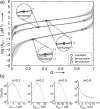Affinity screening using competitive binding with fluorine-19 hyperpolarized ligands
- PMID: 25703090
- PMCID: PMC4472436
- DOI: 10.1002/anie.201411424
Affinity screening using competitive binding with fluorine-19 hyperpolarized ligands
Abstract
Fluorine-19 NMR and hyperpolarization form a powerful combination for drug screening. Under a competitive equilibrium with a selected fluorinated reporter ligand, the dissociation constant (K(D)) of other ligands of interest is measurable using a single-scan Carr-Purcell-Meiboom-Gill (CPMG) experiment, without the need for a titration. This method is demonstrated by characterizing the binding of three ligands with different affinities for the serine protease trypsin. Monte Carlo simulations show that the highest accuracy is obtained when about one-half of the bound reporter ligand is displaced in the binding competition. Such conditions can be achieved over a wide range of affinities, allowing for rapid screening of non-fluorinated compounds when a single fluorinated ligand for the binding pocket of interest is known.
Keywords: NMR spectroscopy; drug discovery; hyperpolarization; protein-ligand interaction.
© 2015 WILEY-VCH Verlag GmbH & Co. KGaA, Weinheim.
Figures



Similar articles
-
Determination of binding affinities using hyperpolarized NMR with simultaneous 4-channel detection.J Magn Reson. 2018 Oct;295:80-86. doi: 10.1016/j.jmr.2018.08.002. Epub 2018 Aug 13. J Magn Reson. 2018. PMID: 30144688 Free PMC article.
-
Nuclear magnetic resonance of hyperpolarized fluorine for characterization of protein-ligand interactions.J Am Chem Soc. 2012 Oct 24;134(42):17448-51. doi: 10.1021/ja308437h. Epub 2012 Oct 9. J Am Chem Soc. 2012. PMID: 23020226
-
An improved 19 F-CPMG scheme for detecting binding of polyfluorinated molecules to biological receptors.Magn Reson Chem. 2017 Apr;55(4):355-358. doi: 10.1002/mrc.4531. Epub 2016 Nov 3. Magn Reson Chem. 2017. PMID: 27661784 No abstract available.
-
NMR-based screening methods for lead discovery.EXS. 2003;(93):183-202. doi: 10.1007/978-3-0348-7997-2_9. EXS. 2003. PMID: 12613177 Review.
-
Detection of site-specific binding and co-binding of ligands to macromolecules using 19F NMR.Life Sci. 1991;48(13):1227-40. doi: 10.1016/0024-3205(91)90517-f. Life Sci. 1991. PMID: 2002752 Review.
Cited by
-
Detection of Protein-Ligand Interactions by 19F Nuclear Magnetic Resonance Using Hyperpolarized Water.J Phys Chem Lett. 2022 May 5;13(17):3819-3823. doi: 10.1021/acs.jpclett.2c00448. Epub 2022 Apr 24. J Phys Chem Lett. 2022. PMID: 35465675 Free PMC article.
-
The precious fluorine on the ring: fluorine NMR for biological systems.J Biomol NMR. 2020 Sep;74(8-9):365-379. doi: 10.1007/s10858-020-00331-z. Epub 2020 Jul 10. J Biomol NMR. 2020. PMID: 32651751 Free PMC article.
-
Applications of Dissolution-DNP for NMR Screening.Methods Enzymol. 2019;615:501-526. doi: 10.1016/bs.mie.2018.08.016. Epub 2018 Dec 4. Methods Enzymol. 2019. PMID: 30638540 Free PMC article.
-
Biomolecular interactions studied by low-field NMR using SABRE hyperpolarization.Chem Sci. 2023 Sep 1;14(37):10258-10263. doi: 10.1039/d3sc02365f. eCollection 2023 Sep 27. Chem Sci. 2023. PMID: 37772094 Free PMC article.
-
Porous functionalized polymers enable generating and transporting hyperpolarized mixtures of metabolites.Nat Commun. 2021 Aug 4;12(1):4695. doi: 10.1038/s41467-021-24279-2. Nat Commun. 2021. PMID: 34349114 Free PMC article.
References
-
- Vulpetti A, Hommel U, Landrum G, Lewis R, Dalvit C. J. Am. Chem. Soc. 2009;131:12949–12959. - PubMed
-
- Dalvit C, Ardini E, Fogliatto GP, Mongelli N, Veronesi M. Drug Discov. Today. 2004;9:595–602. - PubMed
-
- Dalvit C, Ardini E, Flocco M, Fogliatto GP, Mongelli N, Veronesi M. J. Am. Chem. Soc. 2003;125:14620–14625. - PubMed
-
- Jenkins BG. Life Sci. 1991;48:1227–1240. - PubMed
Publication types
MeSH terms
Substances
Grants and funding
LinkOut - more resources
Full Text Sources
Other Literature Sources

